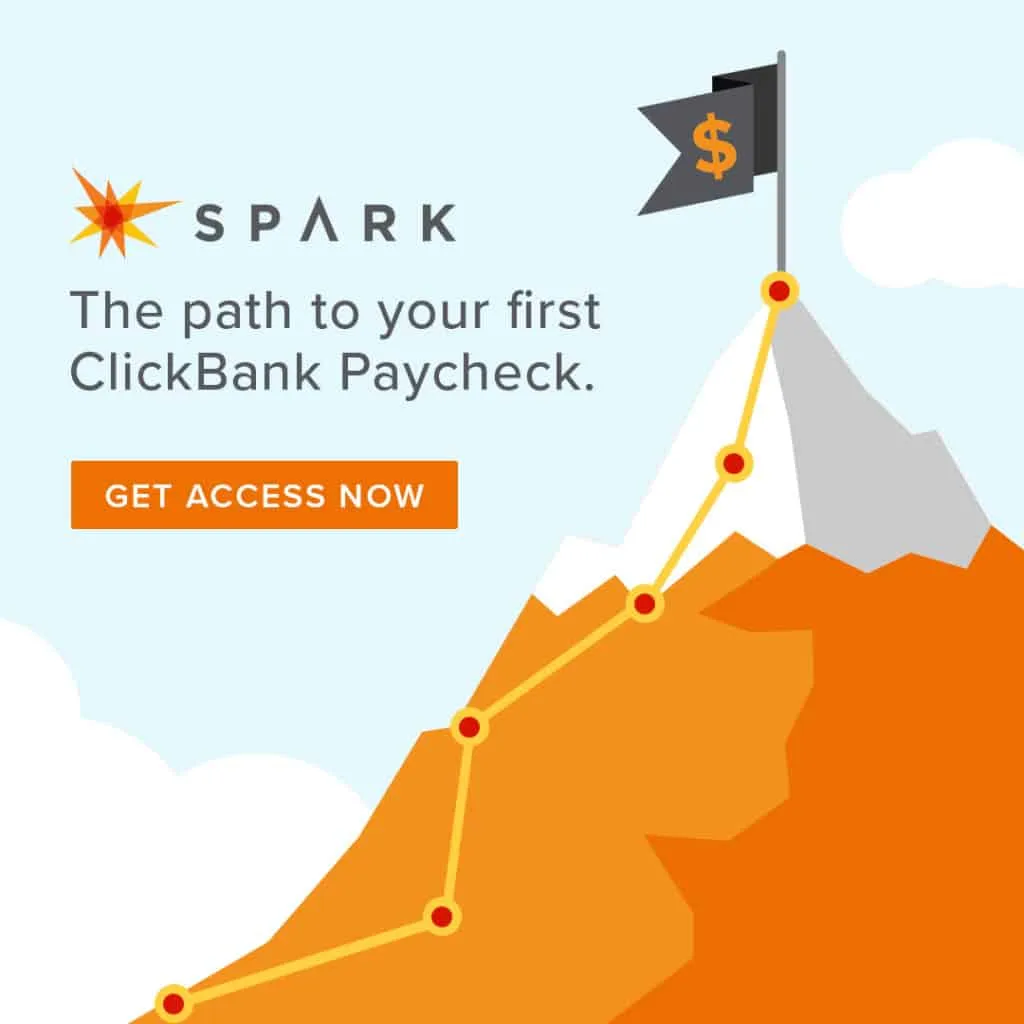The Ultimate Affiliate Marketing Glossary: 67+ Affiliate Marketing Terms You MUST Know!
In the world of affiliate marketing and ecommerce, you’ll hear LOTS of three-letter acronyms thrown around by smart people – so if you’re a little intimidated, don’t feel bad. This jargon can be challenging to understand if you’re not already familiar with it (and sometimes, even if you are!).
Case in point: I’ve been in the affiliate marketing space for a few years already, but I’m still sifting through this massive “alphabet soup” of EPCs, AOVs, LTVs, CPAs, PPCs, and VSLs – and I’m honestly learning new terms every day!
Fortunately, YOU don’t have to work that hard to learn affiliate marketing jargon, because I’ve packed everything you need to know into our official ClickBank affiliate marketing glossary. Our team knows these marketing terms inside and out, and we’re here to share it all with you so you can communicate well with other affiliates, sellers, and partners in the industry.
Read on to discover the 12 most important affiliate marketing terms you’ll encounter – with a detailed explanation of each one and why it matters – followed by a full list of more than 55 other affiliate marketing terms you can refer back to anytime!
The 12 Most Important Affiliate Marketing Terms
1) Earnings Per Click (EPC)
Revenue / total clicks.
The earnings per click (EPC) is a simple way to track performance across different offers, particularly for affiliates who want to see how an offer is performing. EPC is a shorthand for how much money you’re bringing in, and it’s also a helpful counterpart to cost per click (CPC) in making sure that your total spend isn’t exceeding your earnings.
To calculate EPC, simply divide your total revenue by total clicks on your affiliate links (ie HopLinks on ClickBank).
Keep in mind, this is just a benchmark – there’s no one perfect EPC, but as you get more familiar with your chosen niche and offer, you’ll get a clear sense of the average earnings per click you should be aiming for.
2) Average Order Value (AOV)
Total revenue / # of initial orders.
As a seller in the ecommerce space, your average order value (AOV) is a crucial metric in gauging the overall health of your offer.
We should point out that if you have customers who buy from you again and again, this ongoing sales relationship can skew the AOV number – that’s why we specify that AOV refers to “the average amount a customer spends after completing a purchase from you for the first time.” It’s not about how much you make on average from any order, but specifically that all-important initial order.
That’s because affiliates care more about how well the offer performs in general, but the reason AOV matters to product owners is because it helps you determine how much you can spend to acquire a customer (including through affiliates). It’s also a key number in determining the caliber of affiliates you can attract – and whether you’re able to scale your offer with affiliates.
3) Lifetime Value (LTV)
AOV * # of orders per year * average retention time in years.
Customer lifetime value (LTV) is simply how much each customer spends with you in total, on average. You can find it by taking the average order value multiplied by the average number of purchases per year, and then multiplying this by the average amount of retention time you see from your customers.
LTV is similar to AOV, but it’s focused on the long-term, rather than on short-term profits. It includes any ongoing and future revenue from a customer, not just that initial order value.
So, why does it matter? Well, an accurate number for your LTV helps you determine how much you’re able to spend on acquiring a new customer. Unlike with AOV, the LTV includes all spending over the lifetime of a customer – this can give you some extra breathing room in how much you pay to acquire customers, including offering a higher commission to affiliates.
Some sellers even expect to lose money upfront as they build their list, because they know they’ll make it up on the backend thanks to a high LTV – either by selling more of their own products, promoting other affiliate offers, or both.
4) Cost Per Action (CPA)
An affiliate marketing commission model centered around “cost per sale.”
Cost per action (CPA) is a commission model where sellers pay out a flat rate for a specific action. Typically, this action is a new sale – this stands in contrast to offering a % revenue share for each sale.
For example, instead of offering a 75% commission on a $120 order (ie $90), you might offer a flat CPA amount of $70.
To the seller, CPA refers to the flat amount you’ve agreed to pay an affiliate every time they bring you a sale, regardless of any future refunds or chargebacks.
To the affiliate, CPA refers to the flat amount you earn per sale, full stop. If you deliver a sale, you get paid and the funds are yours to keep. This is most helpful if you’re a media buyer who needs to know how much each sale is worth ahead of time. On a smaller scale, revenue share may actually be more profitable, depending on the size of the orders your referred customers purchase – though you share the risk of refunds and chargebacks with the seller as an affiliate.
Ultimately, when you compare CPA and RevShare, the main difference is that refunds only come out of the product owner’s side of the equation, and that affiliates know exactly can calculate exactly how much they’ll make for a given number of sales.
5) Clickthrough Rate (CTR)
# of clicks / # of visitors on a webpage.
The clickthrough rate (CTR) is a pretty straightforward metric. It measures how many people took a specific action – clicking through to the next step in a sales funnel – compared to the number of people who visited the page overall (ie page impressions).
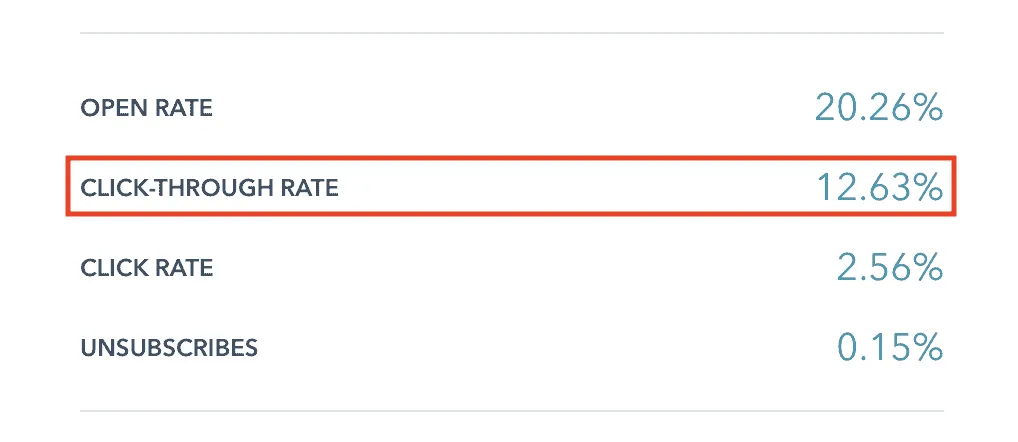
Typically, CTR is a metric you’ll see going from ads to sales pages or from the sales page to an order form. This number can be found in all kinds of digital channels, including paid ads and email.
6) Conversion Rate
# of buyers / # of visitors who saw an offer.
In affiliate marketing, the conversion rate typically refers to the % of people who converted into customers on the order form page.
Usually, a good conversion rate is in the 1-3% range on scaled offers on our marketplace. Of course, it may be a bit higher than this on lower-priced products, and it’s often quite a bit lower on high-ticket affiliate offers.
7) Return on Ad Spend (ROAS)
Total revenue from ads / total ad spend.
The ROAS is a quick way to evaluate how much you made from the money spent on paid ads.
For example, if you made $100 in total and you spent $20 on ads, then your ROAS is 5X. Anything above 1-2X of spend is where you start to see real profits (keeping in mind that the time you spend working on the campaign is valuable, and it usually takes a lot of testing to optimize your ads for profitability).

ROAS is a particularly important number in the Facebook ad buying community – it’s a metric that helps tell you how well your campaign is performing, and it can dictate which affiliate offers you should double down on or move on from.
8) Pay Per Click (PPC)
Total ad cost / # of ads clicked.
Pay per click (PPC) is a shorthand way to refer to paid digital advertising through search engines and social platforms (such as Google and Facebook). The most popular platform for PPC is Google Ads.
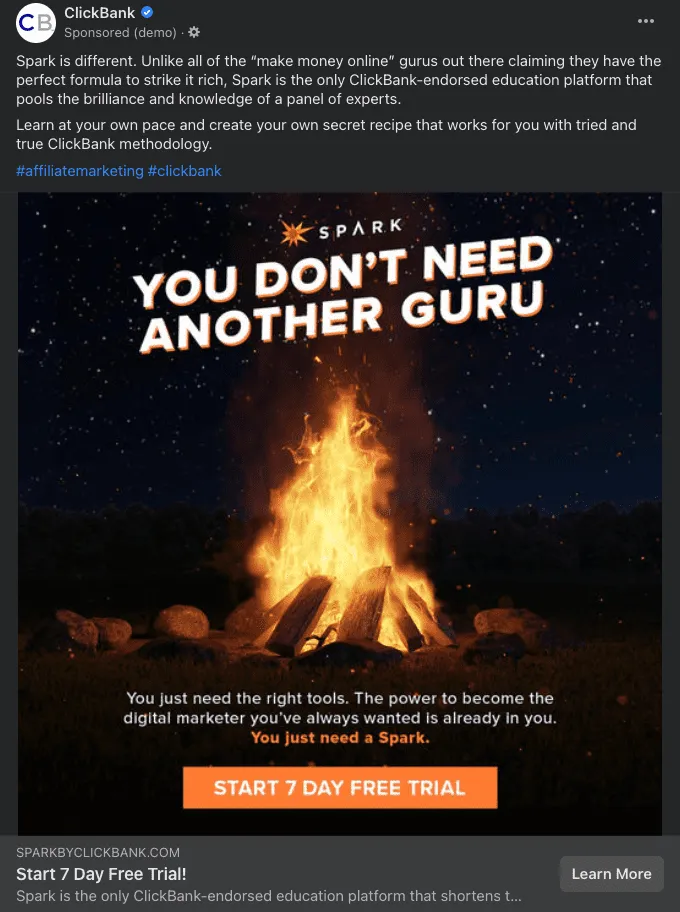
In fact, PPC has its roots in the world of “Google AdWords,” where you would bid on keywords, measured in the number of dollars and cents per click, and only pay each time someone clicked on your text or display ad. This is called “cost per click (CPC)”, and it’s a form of cost per action (CPA).
You’ll also find PPC in native advertising. PPC can be quite profitable – if you bid $2 on an important search term that leads to a sale worth $120, you’ll come out far ahead!
9) Tracking Links
A special URL that tracks behaviors, such as clicks or purchases.
If you’re an affiliate, you’ll generate a special type of tracking link called an “affiliate link” that’s unique to you. If you promote products listed on the ClickBank marketplace, you’ll get a tracking link called a HopLink that gives you credit when you refer new customers who make a purchase.
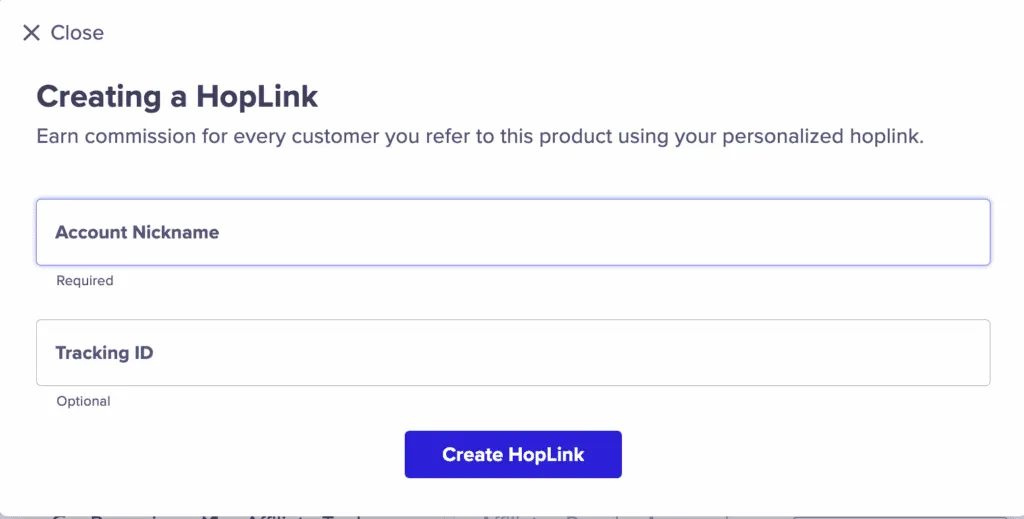
This allows you to get paid commissions as an affiliate – and it all happens automatically through ClickBank’s platform!
10) One Time Offer (OTO)
An additional offer presented in an order flow.
One time offers (or “upsells”) are presented immediately after a purchase on the thank you page. Think of it as a salesperson saying: “Hey, thanks for purchasing something – would you also like this?”
OTOs are often one-click, because the customer has already provided their information. This is a great way to boot the average order value (AOV) for an offer. You may actually see three or four OTOs in some upsell flows, while other offers will have none.
11) Landing Page
The main sales page for a seller.
In affiliate and direct response marketing, the “landing page” is a sales page that an affiliate will send traffic to. This page’s sole purpose is to sell a product or service, usually with a video or text sales letter that moves prospects to make a purchase.
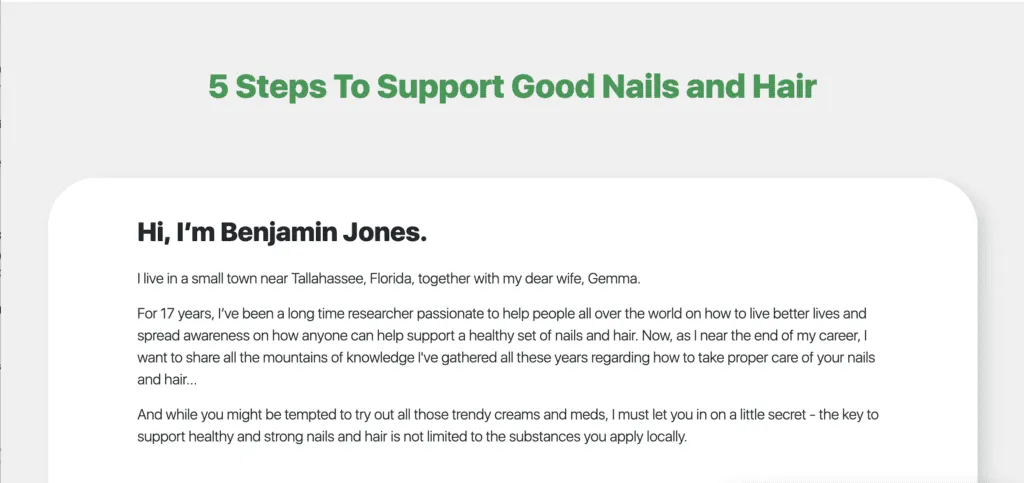
Some marketers will use the term “landing page” interchangeably with “squeeze page,” because it’s designed not to have any distracting elements like a sidebar, main navigation, exit hyperlinks, or any other calls to action besides buying the product – though if you want to get technical baout it, the squeeze page is specifically designed for opt-ins rather than sales.
You may also hear a “landing page” called a “pitch page” or a “sales page.”
12) Sales Letter – Text Sales Letter (TSL) or Video Sales Letter (VSL)
Letters in text or video format designed to convert sales page visitors into buyers.
To successfully sell on a landing page, you need a sales letter. The two main types are text sales letter (TSL) and video sales letter (VSL).
A TSL is basically a page like any other webpage – with text and images – but it’s specifically created to be scannable and encourage the visitor to keep reading. It usually eliminates all navigation elements and other distractions so the reader is focused on the messaging and will make a purchase in that same visit.
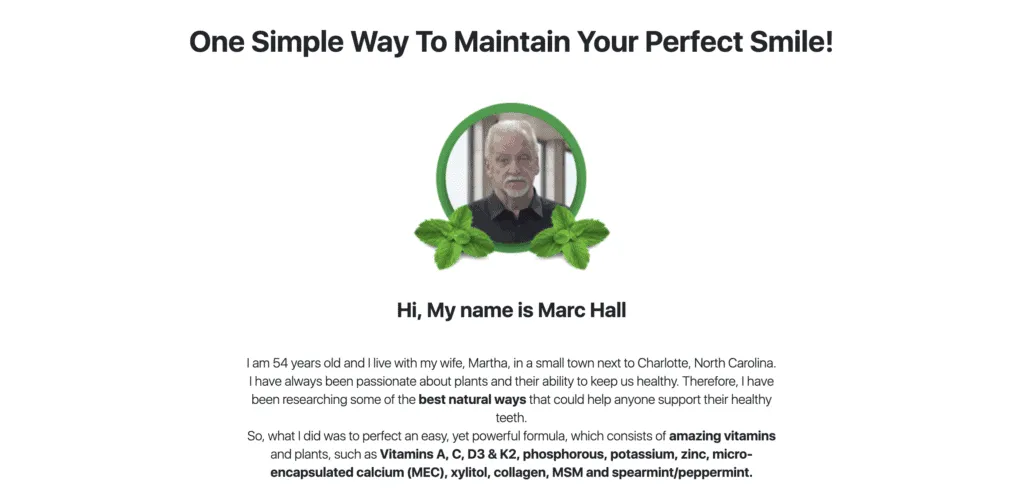
A VSL is a video that’s often the only element on the landing page, and often 30 or 40 minutes long with lots of open loops to keep people watching. It’s a very different type of video than a typical video ad – not only do top ClickBank offers often have VSLs with high production values, but the whole approach behind a VSL is to encourage visitors to keep watching and eventually make a purchase in that same visit.
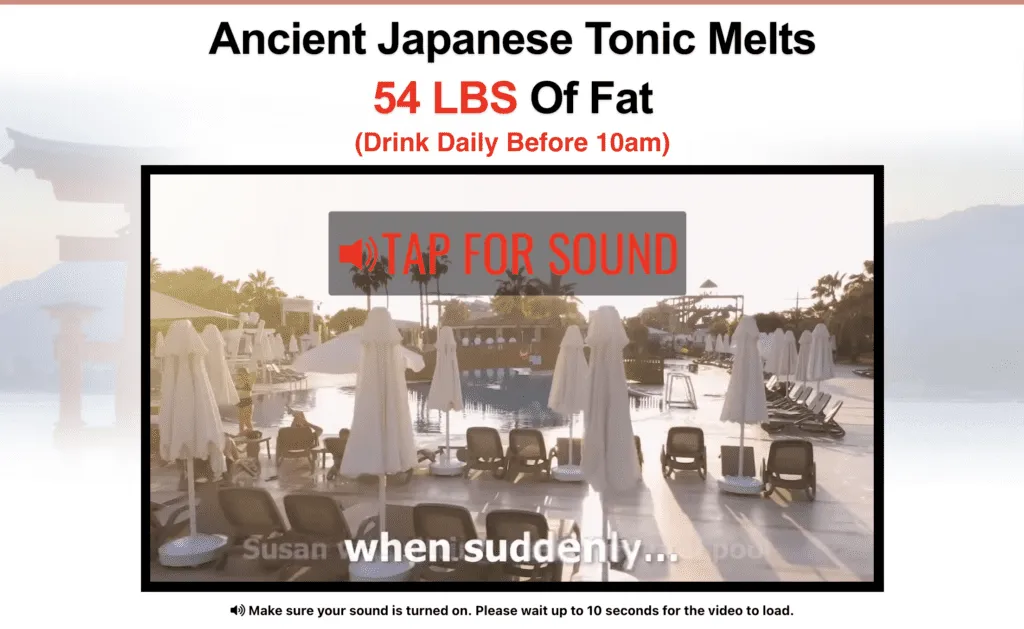
55+ Additional Affiliate Marketing Terms to Know
Ad – An “ad” in the world of ecommerce and affiliate marketing usually refers to a pay-per-click (PPC) ad. This can include video ads on YouTube, Google text or display ads, and various types of ads on social platforms like Facebook, Instagram, and TikTok.
Ad network – An ad network is an online service that connects advertisers and publishers. The most popular ad networks are Meta Ads and Google Ads.
Advertiser – In the ecommerce space, the term “advertiser” usually refers to a seller or brand with a product they need to advertise to get more sales. They’ll do this with paid ads through an ad network or social platform. The counterpart to an advertiser is the “publisher,” a person or company that places ads on a content site that they own.
Affiliate – A business owner or entrepreneur who promotes products or services for a third party in exchange for a commission, typically offered for new sales or leads.
Affiliate link – An affiliate link is a specific type of tracking link that you can generate from a seller to promote their offer. This can be a text link or an image link. (Also see “HopLink”)
Affiliate marketing – An industry built around the model of selling products through affiliates. Each time an affiliate makes a sale for a seller or brand, the affiliate will receive a commission.
Affiliate network – A company that oversees affiliate relationships for a number of other companies, managing functions such as technology, recruitment, tracking, payments, etc. This is similar to the idea of an affiliate marketplace, but not identical.
Affiliate program – An arrangement where a seller pays affiliates who bring them new sales in the form of a commission (either through a cost per action or revenue share model). These can be pretty straightforward or more complicated, depending on the terms of the agreement and how many parties are involved.
AI – Artificial intelligence, sometimes referred to as generative AI (gen AI), AI chatbots, or large language models (LLMs). There are many general-purpose AI chatbots like ChatGPT, Claude, and Perplexity that allow users to engage with the web, as well as many tools powered by AI for a specific use case, such as Descript for video editing, Suno for music generation, ElevenLab for AI-generated voiceover and sound effects, or Jasper for AI copywriting.
Attribution – The concept of attribution applies to all of marketing as a way to determine which marketing channels provided value in making new sales or growing revenue. For example, you can use a tracking link to see how many sales came from an email.
In affiliate marketing, “attribution” has another meaning: who gets credit for a particular customer. In general, affiliate marketing uses last-click attribution, which means the owner of the affiliate link that was clicked most recently before the sale gets the commission, even if they were referred by multiple affiliates.
Average Payout Value (APV) – The average commission amount you get paid for each sale as an affiliate. To find this number, take the average order value (AOV) and multiply it by the commission rate. For example, if the average order value is $100, and your commission rate is 75%, then your average payout value would be $75. This formula applies to RevShare – with a CPA commission, the amount you’re paid per sale is fixed.
Banner ad – An image-based Internet advertisement that can be placed on an affiliate’s website. Banner ads often promote a company as a whole, whereas text links tend to be used for more product-specific promotions.
Bridge Page – The affiliate bridge page (sometimes called a “pre-sell page” or an “interstitial”) is an additional step in the sales funnel between a traffic source and the offer’s pitch page. This bridges the gap between seeing an ad and being asked to make a purchase.
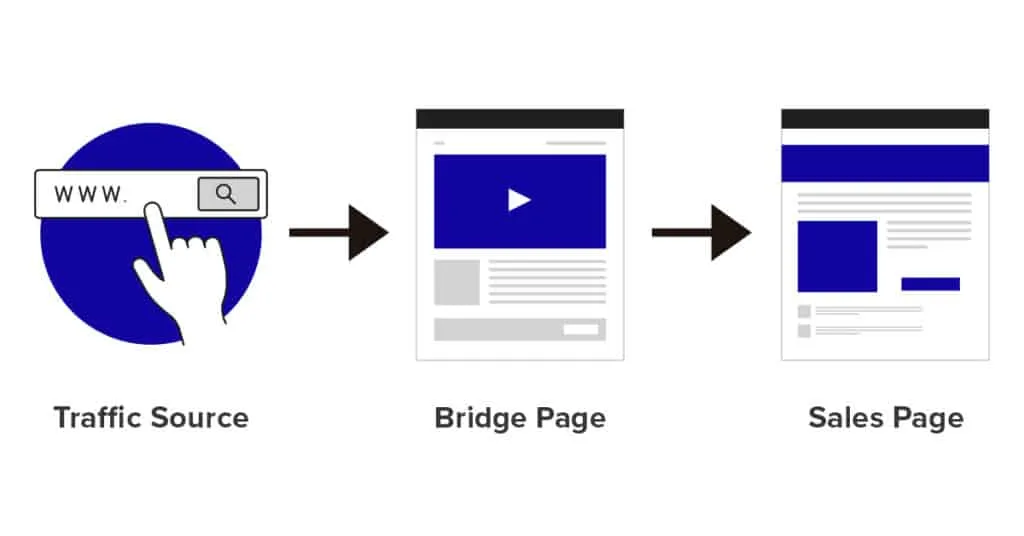
Chargeback – A purchase can be “charged back” when a customer disputes a charge or purchase through their credit provider or bank, usually because the customer claims that the charge or purchase was unauthorized, fraudulent, or unfunded.
Chargebacks cost sellers money and harm their reputation as a trusted online retailer. If you’re an affiliate paid on a RevShare model, you may lose your commission on a sale due to a chargeback – with CPA, only the seller is responsible.
Co-marketing – Co-marketing is an arrangement between two or more parties to promote each other to their own audiences. This often occurs through blog post swaps, email blasts, and social media mentions – and will either be a one-time or ongoing cross-promotional campaign.
Commission – The payout an affiliate receives in exchange for promoting a seller’s product.
Commission Group – At ClickBank, there are different levels of commission that allow sellers to customize the commission rate for different affiliates. Find out more about commission groups.
Commission Rate – The standard rate a seller pays their affiliates in exchange for an offer promotion. On ClickBank, the standard commission rate ranges from 1% to 75%, with the potential for even higher commissions. Products will have wildly different commission rates, depending on the industry, the possibility of recurring revenue, and the competitive landscape.
Commission Models – The two main commission models in affiliate marketing are cost per action (CPA) and revenue share (RevShare). Find out more about CPA vs RevShare.
Conversion – The term “conversion” describes the completion of a specific goal online. Examples of conversion goals include new email subscribers, new opportunities or leads, and new sales or customers. In general, when you hear someone talk conversions in affiliate marketing – especially on ClickBank – it’s about sales on a landing page.
Cookie – A text file that is stored in a browser for a specified period of time (ie cookie duration) in order to hold information such as last date visited. Cookies are used to track unique IDs in the affiliate marketing world.
Cookie Duration – The amount of time a cookie will give credit to an affiliate for purchases made from a specific customer. On ClickBank, this window is 60 days – but across the affiliate marketing industry, it can be anything the seller chooses: 24 hours, 7 days, 30 days, 1 year… This is a key point of negotiation when discussing affiliate terms with a seller. The longer the duration, the more likely you are to get credit for a purchase as an affiliate.
CPC – This is calculated by taking money spent / number of clicks. Cost per click describes how much you have to pay every time your paid ad is clicked, on average. This can change a lot depending on the competitiveness of your niche – in some cases, a $0.30 CPC isn’t great, while in others, a $2.50 CPC is great!
Overall, you can think of CPC as the counterpart to earnings per click (EPC), which describes how much money you make per click as an affiliate. If EPC is higher than CPC, you’re golden – if the opposite is true, you’re actively losing money!
CPM – Cost per mille (CPM) is how much you have to pay to get your display ad or text ad viewed one thousand times. In this case, the CPM is paid out based on impressions, rather than clicks or sales.
Creative – In the marketing world, people often use the word “creative” as shorthand for any images, video, or other visual assets used in an advertisement. This is in contrast to “copy,” which refers to the words that appear.
Email – Email is a key marketing channel that many business owners favor because it’s an asset you can control, unlike third-party platforms like Facebook or YouTube.
Many like to say “The money is in the list,” which refers to an email list of people who fit a certain demographic or audience profile. These are people you can email on a regular basis to sell your own products or promote new offers and bring in consistent income.
NOTE: We actually have a full guide to email marketing metrics for affiliates, if you want to dive more into terminology for email!
ESP – Any business owner operating online will need an email service provider (ESP) to help them host a list and send out both broadcast email and automated email campaigns. Some common examples used in affiliate email marketing include MailChimp, Hubspot, Sendlane, Drip, and ActiveCampaign.
First Click – This type of attribution in affiliate marketing gives credit to the affiliate who first referred a customer to an offer.
Funnel – A sales funnel is a path that online individuals take to go from prospects to customers.
In affiliate marketing, the funnel usually involves taking people from a cold traffic source like Facebook Ads, possibly routing people through an affiliate bridge page, and ultimately sending them over to an offer page. Some funnels may also incorporate email marketing, choosing to build a list and then present offers to engaged subscribers.
Gravity – At ClickBank, we have a special metric called the Gravity Score that measures the momentum of offers on ClickBank’s marketplace, calculated on a 12-week rolling cycle that emphasizes recent sales more than older ones. This score helps you determine which products are seeing sales on ClickBank. Learn more about ClickBank’s Gravity Score here.
HopLink – At ClickBank, the special affiliate link you generate to promote an offer as an affiliate is called a “HopLink,” or a “hop” for short. Learn more about HopLinks here.
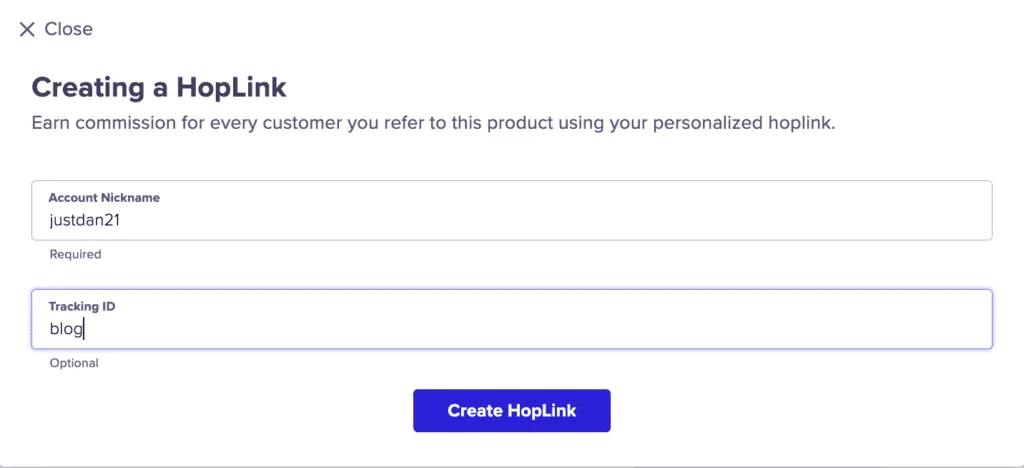
JV – A joint venture(JV) partnership is just that: a partnership between two or more parties in an affiliate marketing venture.
This arrangement allows you to get more creative with how you bring in and distribute revenue. For example, you can set up a percentage of revenue to go to your copywriter, allow upsells from other vendors in your funnel, or even set up second-tier contracts where someone makes money referring an affiliate who makes a sale. Find out more about Joint Venture contracts on ClickBank here.
Impression – An impression is a single view of your ad, video, or webpage. Impressions are a useful way to measure things like conversion rate (how many people took an action compared to total impressions on a page), and they’re also used in the CPM model for pricing.
Last click – This type of attribution in affiliate marketing gives credit to the affiliate who last referred a customer to an offer.
Lead – A lead is a sales contact, prospect, or potential customer, often pursued by businesses that sell high-ticket products or custom services.
Leads can be nurtured through email or engaged directly with a live salesperson to become a customer. Some companies will pay for quality leads using a cost per lead (CPL) commission model.
Merchant – See “Seller”
Native ad – A native ad is a particular type of paid ad or sponsored post that appears on a content site and blends in with the rest of the page.
While most banner ads are clearly advertisements, native ads either match the other content or actually are the content. Native ads often include recommended content on a website or posts appearing in a social media feed. Two of the most popular native ad networks are Outbrain and Taboola.
Niche – A niche is a specialized market, audience, or topic area that you can monetize.
A quick browse on ClickBank’s marketplace will reveal dozens of niche categories and sub-categories, from business/investing to green products to spirituality. It helps to focus on a particular niche so you get familiar with the audience, the competitive landscape, and the types of offers that tend to do well.
Offer – An affiliate offer is a product you can promote as an affiliate. (Also see “product”)
Paid ad – A paid ad is a pay-per-click (PPC) ad that appears on a content website, social feed, or search engine results page. (See “Pay-per-click” for more.)

Payment threshold – The payment threshold is how much money you need to have accumulated in your account before a payment is issued. The default payment threshold at ClickBank is $100, but it can start as low as $10. This number varies by affiliate network or affiliate program.
Payout – The payout is the amount of money you make as an affiliate per conversion.
At ClickBank, we sometimes share the average payout value (AOV) of an offer, which tells you how much you can usually expect to make from a RevShare commission on that offer. With CPA on ClickBank, the payout is a flat amount agreed upon between the seller and each affiliate they work with.
Pixel – In affiliate marketing, the word “pixel” is used a shorthand nickname for the Facebook Pixel, an analytics tool that helps you measure the results of your Facebook Ads in sending traffic to a landing page.
Product – In affiliate marketing, a product is any kind of offer that a seller has for sale on a dedicated landing page. Usually, a ClickBank seller’s product is available for affiliates to promote in exchange for a commission payment. Learn more about the top products on ClickBank here.
Product Owner – The term “product owner” is basically another name for a seller or vendor. It’s the business owner or brand with a product to sell online. You can learn more about getting started as a product owner in our scalable affiliate program guide!
Publisher – In the affiliate marketing space, content site owners are sometimes referred to as “publishers.” This is because they release content to an audience and help promote sellers’ products using display ads, native ads, or original content containing affiliate links.
Refund – In ecommerce, as with traditional retail, some people decide to return a product they purchased and get their money back. Refunds are part of the equation for any product sold through affiliate marketing – though both sellers and affiliates are motivated to minimize the number of refunds so they can make more profits.
Retargeting / remarketing – Retargeting or remarketing is a marketing tactic you can use on platforms like Google and Facebook to serve ads to users based on certain criteria, such as someone who visited the order page and never bought. These ads are often more lucrative than ads to cold traffic, because they’re targeting users who have already expressed some interest in an offer or product.
RevShare – RevShare is a commission model where the seller designates a percentage of each sale to go to an affiliate. The affiliate shares in both the risk and the reward – affiliates can lose their commission if the customer decides to return the product or dispute the charge, but can make more overall when the order value is higher.
ROI – Return on investment (ROI) is how much money you get back from the money invested in marketing overall. This is a broader metric than ROAS, which is focused strictly on ad spend. A good marketing ROI to aim for is 5:1, which means every dollar you spend on marketing brings in $5.
Search – People often refer to “search” as a primary marketing channel for affiliate marketing. It’s generally used as shorthand for SEO.
Seller – Any business owner or brand with a product to sell through affiliate marketing. Sellers can be an individual with an ebook, a lean SaaS startup, a multi-billion dollar ecommerce brand, or anything in between!
SEM – Search engine marketing (SEM) is an area of marketing focused on generating results from paid search or pay-per-click ads, especially Google. This is contrast to SEO, which is ranking in search for organic traffic. Many affiliates use SEM, either as a way to send cold traffic directly to an offer, or to build an email list of buyers they can present offers to later.
SEO – Search engine optimization (SEO) is an area of marketing focused on growing organic traffic to a website from search engines like Google. SEO blends the skills of content creation, on-page optimization, and off-page SEO like link building to rank on page 1 of Google. In affiliate marketing, some affiliates will build out content sites with the goal of generating free traffic that will click affiliate links on their website or sign up for their email list.
SERP – The search engine results page (SERP) is the page a user sees after typing a search term into a search engine like Google.
Squeeze page – A specific type of landing page designed to with no exit hyperlinks and the goal of capturing visitors’ contact information for follow-up. (See “landing page” for more.)
Traffic – A measure of the number of visitors to an ad, webpage, or website. You can have free traffic – primarily from SEO, email, and organic social – or paid traffic for PPC ads. In affiliate marketing, an affiliate is typically concerned with how much traffic they can send to an offer, and secondarily, how much traffic they’re getting to their content site, if they own one.
Vendor – See “seller”
Vertical – See “niche”
How to Use This Affiliate Marketing Glossary
Be honest… did you quickly scan through all of those affiliate marketing terms and end up here?
If you did, it’s totally understandable! Unless you’re a Grade-A marketing nerd, reading definitions is pretty dry. But it’s also incredibly important to understand affiliate marketing jargon, because the terms tell you a lot about how all of this affiliate marketing stuff fits together.
I would recommend actually reading this affiliate marketing glossary all the way through once, and then bookmarking the page (I know, some people still do that!). That will make it easy to refer back here if you forget the exact definition of something (who can remember what the heck “last click attribution” is, anyway?).
Most importantly, the next time someone asks you to go in as a JV partner with the seller in exchange for use of your email list to drive traffic to a landing page for maximum conversions in a RevShare commission model…
(Deep breath!)
… Then you’ll know what they mean!
Ultimate Affiliate Marketing Glossary Conclusion
There’s no way we could possibly cover ALL the acronyms and jargon specific to affiliate marketing in just one article, but hopefully, this post gives you a solid foundation on the key terms you need to keep up in this fast-paced industry!
NOTE: We also have another in-depth article about key affiliate marketing metrics, if you want to learn more about those.
Lastly, you should take a look at our Spark by ClickBank affiliate education portal to dive deeper into the nuts and bolts of affiliate marketing. It’s one thing to read about these different marketing terms – but it’s another thing entirely to see them in action!
With Spark, you’ll learn all about the foundations of affiliate marketing and how to succeed as an affiliate. Check it out!
